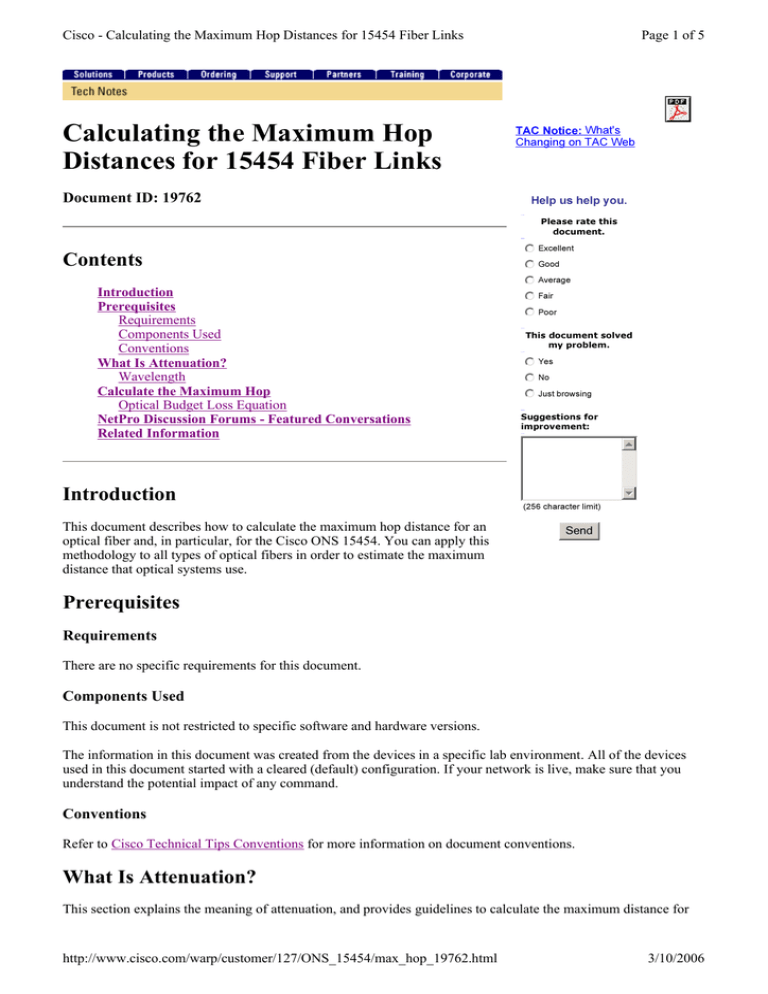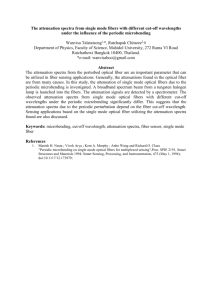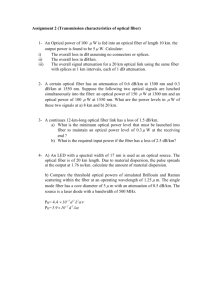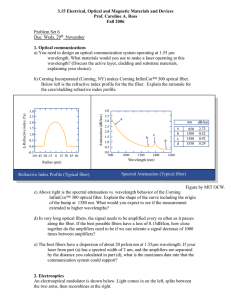
Cisco - Calculating the Maximum Hop Distances for 15454 Fiber Links
Calculating the Maximum Hop
Distances for 15454 Fiber Links
Document ID: 19762
Page 1 of 5
TAC Notice: What's
C han g i n g o n T A C We b
H el p u s h el p y ou .
Please rate this
d o c u m en t.
Contents
Introduction
Prerequisites
Requirements
Components Used
Conventions
What Is Attenuation?
Wavelength
Calculate the Maximum Hop
Optical Budget Loss Equation
NetPro Discussion Forums - Featured Conversations
Related Information
Introduction
This document describes how to calculate the maximum hop distance for an
optical fiber and, in particular, for the Cisco ONS 15454. You can apply this
methodology to all types of optical fibers in order to estimate the maximum
distance that optical systems use.
j Excellent
k
l
m
n
nG
j
k
l
m
o o d
jF
k
l
m
n
a ir
j
k
l
m
n
A v er a g e
j
k
l
m
n
P o o r
T his d o c u m en t so lv ed
m y p ro b lem .
jY
k
l
m
n
es
jJ
k
l
m
n
u s t b r o w s i ng
j
k
l
m
n
N o
S u g g estio n s f o r
im p ro v em en t:
( 2 5 6 ch a r a cter li m i t)
Send
Prerequisites
Requirements
There are no specific requirements for this document.
Components Used
This document is not restricted to specific software and hardware versions.
The information in this document was created from the devices in a specific lab environment. All of the devices
used in this document started with a cleared (default) configuration. If your network is live, make sure that you
understand the potential impact of any command.
Conventions
Refer to Cisco Technical Tips Conventions for more information on document conventions.
What Is Attenuation?
This section explains the meaning of attenuation, and provides guidelines to calculate the maximum distance for
http://www.cisco.com/warp/customer/127/ONS_15454/max_hop_19762.html
3/10/2006
Cisco - Calculating the Maximum Hop Distances for 15454 Fiber Links
Page 2 of 5
optical links on the basis of different wavelengths.
Attenuation is a measure of the loss of signal strength or light power that occurs as light pulses propagate through
a run of multimode or single-mode fiber. Measurements are typically defined in terms of decibels or dB/km.
Wavelength
The most common peak wavelengths are 780 nm, 850 nm, 1310 nm, 1550 nm, and 1625 nm. The 850 nm region,
referred to as the first window, was used initially because this region supported the original LED and detector
technology. Today, the 1310 nm region is popular because of the dramatically lower loss and lower dispersion.
The 1550 nm region also is used today, and can avoid the need for repeaters. Generally, performance and cost
increase as wavelength increases.
Multimode and single-mode fiber use different fiber types or sizes. For example, single-mode fiber uses 9/125 um
and multimode uses 62.5/125 or 50/125. The different size fibers have different optical loss dB/km values. Fiber
loss depends heavily on the operating wavelength. Practical fibers have the lowest loss at 1550 nm and the highest
loss at 780 nm with all physical fiber sizes (for example, 9/125 or 62.5/125).
When you calculate the maximum distance for any optical link, consider the details provided in table 1 and table 2:
Table 1 – For Wavelength 1310nm
Attenuation/ Attenuation/optical Attenuation/joint
Conditions
km (dB/km)
connector (dB)
(dB)
0.30
0.40
0.02
Best
conditions
Average 0.38
0.60
0.10
Normal
Max
1.00
0.20
Worst
situation
Min
0.50
Table 2 – For Wavelength 1550nm
Attenuation/ Attenuation/optical Attenuation/joint
Conditions
km (dB/km)
connector (dB)
(dB)
0.17
0.20
0.01
Best
conditions
Average 0.22
0.35
0.05
Normal
Max
0.70
0.10
Worst
situation
Min
0.04
Here is an example of a typical situation in the field:
http://www.cisco.com/warp/customer/127/ONS_15454/max_hop_19762.html
3/10/2006
Cisco - Calculating the Maximum Hop Distances for 15454 Fiber Links
Page 3 of 5
Table 3 – For ONS 15454
Card
Fiber Light Levels
Rx Level
Tx Level
Max - Min
Max - Min
OC3
-8 to -28
-8 to -15
OC12
-8 to -28
-8 to -15
OC12
-8 to -28
+2 to -3
OC12
-8 to -28
+2 to -3
OC48
0 to -18
0 to -5
OC48
-8 to -28
+3 to -2
OC48
-8 to -28
0 to -2
Table 4 – For OC192 LR and STM64 LH 1550
Tx/Rx
Max
Min
Transmitter (Tx) Output
Max. +10 dBm
Power:
Min. +7 dBm
Receiver (Rx) Level:
Min: -19 dBm
Max. -10 dBm
For this card, the power budget is between: 29dB and 17 dB.
Calculate the Maximum Hop
With the information provided in the What Is Attenuation? section, you can calculate all the attenuation for any
span, including the maximum hop distance for the Cisco ONS 15454.
Optical Budget Loss Equation
Atotal = (wavelength λ loss dB/km x fibre length) + (connector loss x number of connectors) + (splice loss x
number of splices).
http://www.cisco.com/warp/customer/127/ONS_15454/max_hop_19762.html
3/10/2006
Cisco - Calculating the Maximum Hop Distances for 15454 Fiber Links
Page 4 of 5
Kilometer to Mile Conversion
Km x .6214 = miles (1mile = 1.60km)
Here is an example to calculate the maximum hop distance for the OC48 LR 1550 card. For this card:
Min Rx level is -28dB and Min Tx level is -2dB
Max Rx level is -8dB and Max Tx level is +3dB
For this card, the power budget is between: 31dB and 6 dB.
Given that the maximum Rx level is -8dB, this means that if the laser power source is "hotter", the board can
suffer damage. Also, because the Min Rx level = -28dB, you cannot receive beyond this limit.
With this in mind, assume that:
The minimum attenuation on line must be at least:
A(min) = Max Tx level - Max Rx level = +3dB - (- 8dB) = 11dB
The maximum attenuation on line must be:
A(max) = Min Tx level - Min Rx level = -2dB - (- 28dB) = 26dB
You also need to take a system margin into consideration. Patch cords, cable bend, unpredictable optical
attenuation events, and so on, require around 3dB. In addition, a number of splices in elementary cable section
some external connectors (you can have at least two at of possibly 0.7dB so you can consider this to be around 1.5
dB).
On the basis of this information, you can estimate that the new values for calculation are:
A(min) = 11dB - 4.5dB = 6.5dB
A(max) = 26dB - 4.5dB = 21.5dB
With these results, you can conclude that the maximum attenuation for optical cable (TA) must be maximum 26dB
for one link with OC48 LR 1550, and cannot be less than 11 dB.
This takes these conditions into account:
The minimum length for the optical fiber on a cable is:
L(min) = A(min) / a= 6.5dB/ 0.22dB/km = 29.5km
The maximum length for the optical fiber on a cable is:
L(max) = A(max) / a = 21.5dB/ 0.22dB/km = 97.72km
where, a = attenuation for the optical cable (dB/km).
On the basis of this calculation, the maximum hop distance for the OC48 LR 1550 card is between 29.5km and
97.72km.
With this procedure as a basis, you can now calculate all others spans.
NetPro Discussion Forums - Featured Conversations
http://www.cisco.com/warp/customer/127/ONS_15454/max_hop_19762.html
3/10/2006
Cisco - Calculating the Maximum Hop Distances for 15454 Fiber Links
Page 5 of 5
Networking Professionals Connection is a forum for networking professionals to share questions, suggestions, and
information about networking solutions, products, and technologies. The featured links are some of the most
recent conversations available in this technology.
NetPro Discussion Forums - Featured Conversations for Optical
Service Providers: Optical Networking
PA-MC-STM1 card configuration for full bandwidth - Mar 7, 2006
Studying cisco optical specialist - Mar 7, 2006
Question POS point to point with no APS - Mar 6, 2006
Dark Fiber Solution - Mar 1, 2006
10 Gigabit module for 6500 - Feb 26, 2006
Service Providers: Metro
Metro E design question - Mar 9, 2006
confussed between the vlan mode and switch mode AToMPLS - Mar 8, 2006
Sup 720 3xlb and ATOMPLS - Mar 8, 2006
Metro Switches - Mar 8, 2006
pppoe limit max-sessions - Mar 7, 2006
Related Information
Technical Support & Documentation - Cisco Systems
All contents are Copyright © 1992-2006 Cisco Systems, Inc. All rights reserved. Important Notices and Privacy Statement.
Updated: Mar 08, 2006
http://www.cisco.com/warp/customer/127/ONS_15454/max_hop_19762.html
Document ID: 19762
3/10/2006






